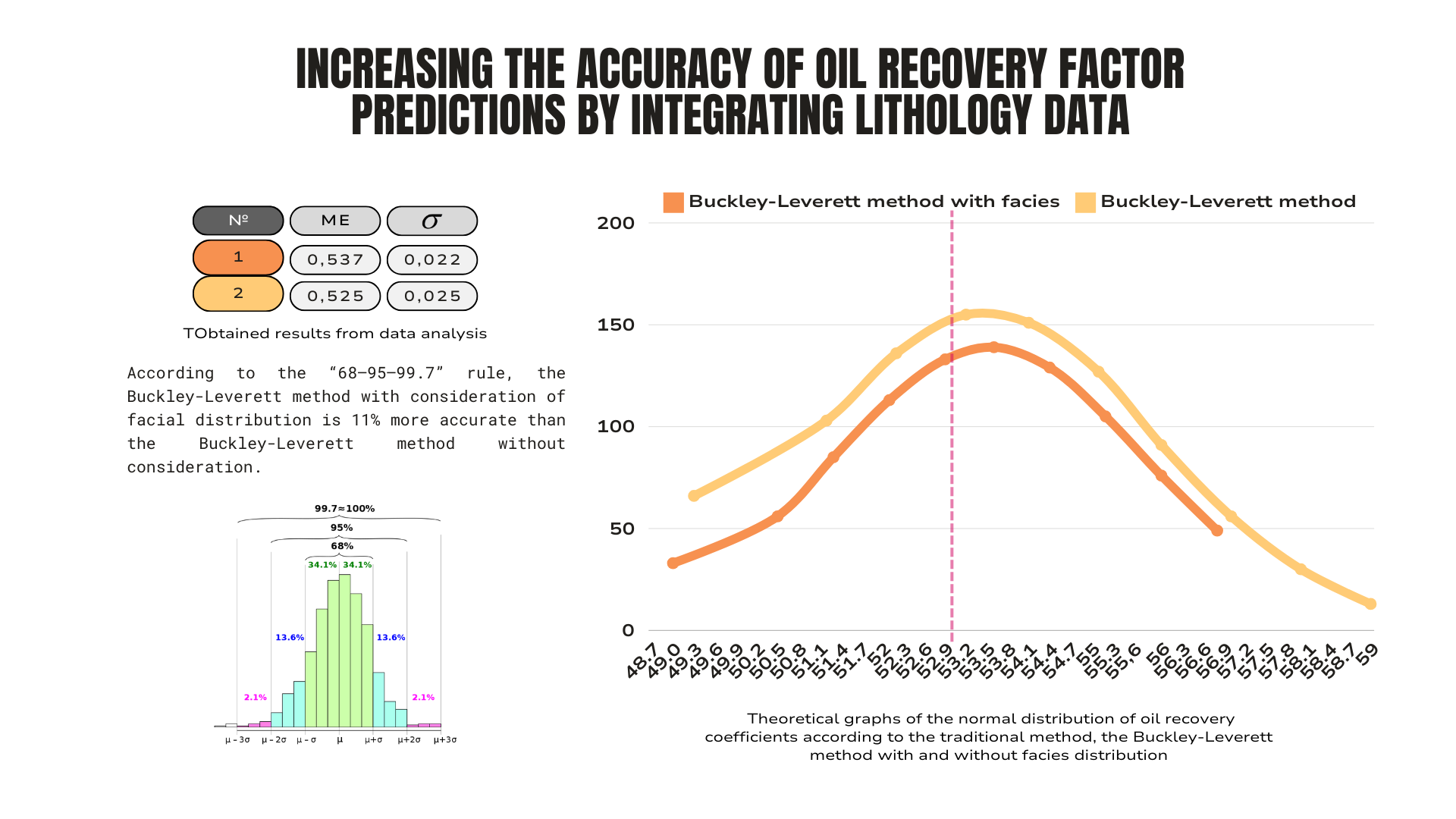Increasing the accuracy of oil recovery factor predictions by integrating lithology data
DOI:
https://doi.org/10.15587/2706-5448.2024.307628Keywords:
oil recovery coefficient, Buckley-Leverett method, waterflooding, fractional flow curves, oil production, lithofacies dataAbstract
The object of research in the paper is the process of oil extraction during flooding. The Buckley-Leverett method, which is widely used to estimate oil production in flooding, has certain limitations that lead to uncertainty in the results. This paper proposes to extend the Buckley-Leverett algorithm by integrating lithological data. This approach allows to take into account the influence of geological characteristics of the formation on the process of displacement of oil by water, which leads to a significant increase in the accuracy of forecasting the oil production coefficient. The effectiveness of the proposed method is confirmed on the basis of data analysis of a real oil field.
The methodology for calculating the oil recovery coefficient during flooding using lithological dissection is presented. In this work, the steps of determining the oil recovery coefficient were analytically determined, which achieves a certain degree of accuracy due to the inclusion of the lithological characteristics of the permeable zone of the formation. The basic calculation of the lithological distribution over the layer was performed using the Kriging method. To confirm the accuracy of the Buckley-Leverett method, taking into account lithological dissection, the use of data analysis, including an experimental histogram and a theoretical normal distribution plot, is proposed. For data analysis, one hundred cases of lithological distribution were generated using the Sequential Indicator Simulation method.
The comparative analysis of the data of the experimental histogram and the theoretical graph of the normal distribution of the determination of oil recovery coefficients by the Buckley-Leverett method for cases with and without lithological dismemberment allows to quantitatively assess the accuracy of both studied options. On the basis of a real oil field, it is shown that the accuracy of oil recovery coefficients by the Buckley-Leverett method, taking into account lithological fragmentation, exceeds the similar method without taking into account lithological fragmentation by 11 %.
References
- Cvetkovic, B. (2009). Well Production Decline. Available at: https://www.semanticscholar.org/paper/Well-Production-Decline-Cvetkovi%C4%87/7a541f814c78fa6579b510db902cb958b9a3eab0
- Blunt, M. J. (2017). Multiphase flow in permeable media: A pore-scale perspective. Cambridge university press. doi: https://doi.org/10.1017/9781316145098
- Martus, O., Petrash, O. (2022). Improved methodology development for assessing the reservoir collector properties by the quantitative reservoir characterization tools. Technology Audit and Production Reserves, 4 (1 (66)), 42–46. doi: https://doi.org/10.15587/2706-5448.2022.263640
- Martus, O., Agarkov, V. (2022). Development of improved method for evaluation of reservoir properties of formation. Technology Audit and Production Reserves, 5 (1 (67)), 33–37. doi: https://doi.org/10.15587/2706-5448.2022.266572
- Martus, O., Cvetkovic, B. (2023). Development of oil extraction screening methodology taking into account innovative methods using the example of the Ukrainian field. Technology Audit and Production Reserves, 6 (1 (74)), 47–53. doi: https://doi.org/10.15587/2706-5448.2023.294081
- Leverett, M. C. (1941). Capillary Behavior in Porous Solids. Transactions of the AIME, 142 (1), 152–169. doi: https://doi.org/10.2118/941152-g
- Buckley, S. E., Leverett, M. C. (1942). Mechanism of Fluid Displacement in Sands. Transactions of the AIME, 146 (1), 107–116. doi: https://doi.org/10.2118/942107-g
- Willhite, G. P. (1986). Waterflooding. SPE Textbook Series. Richardson. doi: https://doi.org/10.2118/9781555630058
- Singh, S. P., Kiel, O. G. (1982). Waterflood design (pattern, rate, and timing). SPE International Oil and Gas Conference and Exhibition in China (SPE-10024). doi: https://doi.org/10.2523/10024-ms
- Forrest, F., Craig, J. (1971). The reservoir engineering aspects of waterflooding. Society of Petroleum.
- Langnes, G. L., Robertson Jr, J. O., Chilingar, G. V. (1972). Secondary recovery and carbonate reservoirs. American Elsevier Publishing Company, 304.
- Interstate Oil Compact Commission. (1983). Improved Oil Recovery.
- Huber, F. (2018). A logical introduction to probability and induction. Oxford University Press, 304.
- Ringrose, P., Bentley, M. (2016). Upscaling Flow Properties. Reservoir model design. Germany: Springer, 115–149. doi: https://doi.org/10.1007/978-94-007-5497-3_4
- Bear, J. (2013). Dynamics of fluids in porous media. Courier Corporation.
- Lyons, W. (2010). Working guide to reservoir engineering. Gulf professional publishing. doi: https://doi.org/10.1016/c2009-0-30573-5
- Mizuno, T., Deutsch, C. (2022). Sequential indicator simulation (SIS).
- Beucher, H., Renard, D. (2016). Truncated Gaussian and derived methods. Comptes Rendus Geoscience, 348 (7), 510–519. doi: https://doi.org/10.1016/j.crte.2015.10.004
- Matheron, G. (1963). Principles of geostatistics. Economic Geology, 58 (8), 1246–1266. doi: https://doi.org/10.2113/gsecongeo.58.8.1246
- Bohling, G. (2005). Introduction to geostatistics and variogram analysis. Kansas geological survey, 1 (10), 1–20.
- Isaaks, E. H., Srivastava, R. M. (1990). An Introduction to Applied Geostatistics. Oxford University Press, 592. Available at: https://geostatisticslessons.com/pdfs/sequentialindicatorsim.pdf

Downloads
Published
How to Cite
Issue
Section
License
Copyright (c) 2024 Olena Martus, Branimir Cvetkovic

This work is licensed under a Creative Commons Attribution 4.0 International License.
The consolidation and conditions for the transfer of copyright (identification of authorship) is carried out in the License Agreement. In particular, the authors reserve the right to the authorship of their manuscript and transfer the first publication of this work to the journal under the terms of the Creative Commons CC BY license. At the same time, they have the right to conclude on their own additional agreements concerning the non-exclusive distribution of the work in the form in which it was published by this journal, but provided that the link to the first publication of the article in this journal is preserved.







